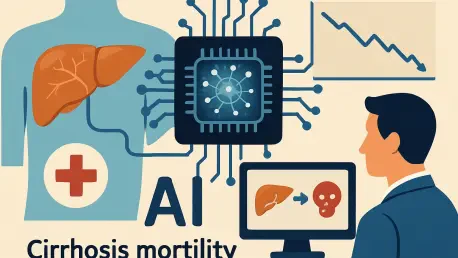Understanding which hospitalized patients with cirrhosis face the highest risk of mortality is a pressing challenge in modern healthcare. Years of research and development have culminated in an AI model designed to accurately predict mortality risk for these patients, significantly aiding healthcare providers in delivering targeted care. By addressing the potentially fatal outcomes associated with liver complications, this breakthrough opens new avenues for timely medical interventions.
The Journey to an AI-Driven Mortality Prediction
The initiative to harness AI for predicting mortality risks emerged from a need to innovate within healthcare settings, particularly in managing patients with severe liver disease. Cirrhosis remains a predominant cause of repeated hospitalizations, fraught with complications like renal failure and severe infections. Traditional approaches often fall short in anticipating outcomes. Thus, the AI initiative led by the CLEARED Consortium and Dr. Jasmohan Bajaj spurred the need to develop a more precise predictive mechanism. By leveraging a vast consortium of international data, enriched with over 7,000 detailed patient records, the team’s endeavor reflects a critical technological evolution aimed at enhancing patient care and decision-making frameworks.
Dissecting the AI Model: Features and Innovations
The Backbone: Random Forest Model
At the heart of this AI innovation is the Random Forest analysis model, a sophisticated algorithm that has distinguished itself by outperforming traditional predictive models. By integrating vast amounts of patient data, this model has been fine-tuned to perceive subtle patterns often overlooked by conventional methods, boasting a high accuracy rate of 0.815. The model’s efficiency in identifying key risk indicators without compromising predictive quality when reduced to 15 core risk factors underscores its significance. This reduction also ensures its feasibility for global application, making advanced prediction capabilities accessible to healthcare providers worldwide.
Integrating Comprehensive Health Data
A pivotal component of this AI model is its capacity to seamlessly integrate extensive health data. The inclusion of variables such as hospital admission causes, complications, treatments, and outcomes allows the system to contextualize and refine its predictions. The model’s capacity to draw from a diverse international database adds robustness, further enhancing its ability to generalize across varying demographics and healthcare contexts. This comprehensive integration fosters an enriched data environment, amplifying the model’s prediction accuracy and its capacity to illuminate new insights into patient management.
Charting New Terrains: Recent Progress and Innovations
The past years have witnessed transformative progressions in AI-enhanced mortality prediction. Technological advancements have incorporated refined machine learning algorithms capable of delivering accurate predictions swiftly, even when dealing with complex datasets. These innovations echo a trend in healthcare to adopt predictive technologies that significantly reshape clinical practices. The model’s adaptability and demonstrable success across diverse healthcare settings exemplify the shift toward data-backed medical interventions, cementing AI’s role as a cornerstone in contemporary healthcare evolution.
Real-World Impact: Transformations in Healthcare Delivery
The AI model’s introduction into clinical practice has showcased its real-world potential in reshaping patient care dynamics. Across various healthcare settings, from specialized liver treatment centers to general hospitals, its deployment has been pivotal. The model enables clinicians to preemptively identify high-risk cases, strategize interventions, and allocate medical resources more efficiently. In cirrhosis management, it has proven invaluable, guiding decisions for critical care escalation, timely transplant preparations, and early palliative care engagements—all contributing to improved patient survival and quality of care.
Recognizing Challenges and Navigating Limitations
Implementing an AI-based system within healthcare is not without challenges. Technical hurdles such as data standardization, integration issues with existing IT infrastructure, and the constant need to validate AI performance across diverse populations are prominent. Moreover, regulatory concerns surrounding data privacy and ethical considerations pose significant barriers to broader adoption. Continued research efforts working to refine algorithms, coupled with international regulatory collaboration, are pivotal to overcoming these limitations and fully leveraging AI in healthcare.
Looking Ahead: The Bright Horizon for AI in Healthcare
The future trajectory of AI in predicting mortality among cirrhosis patients appears promising. Further developments are anticipated to enhance model accuracy, embrace richer datasets, and facilitate real-time analytics. Breakthroughs in AI integration into electronic health records could expedite patient data analysis, offering healthcare providers a more dynamic tool for patient assessment. On a broader scale, continuous innovation could see this AI model influence a spectrum of medical fields, reinforcing its potential as a transformative asset within healthcare.
Navigating Future Innovations
This review underscores the pivotal role of AI in advancing predictive healthcare technologies. The model’s current achievements and ongoing enhancements signify a leap toward precision medicine, facilitating informed decision-making and resource optimization. As the technology matures and integrates more seamlessly into healthcare ecosystems, its transformative impact is set to reshape patient care deeply, offering new prospects in life-saving interventions and healthcare delivery. Looking forward, this technology represents a cornerstone of future medical innovation, poised to continually uplift patient care standards and outcomes on a global scale.









